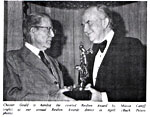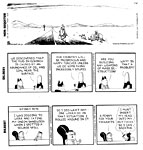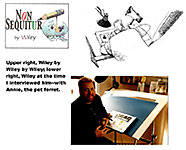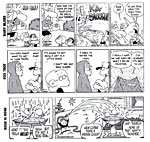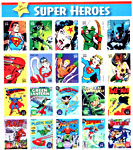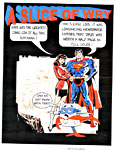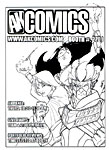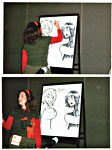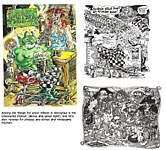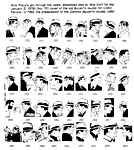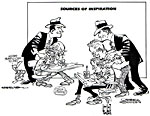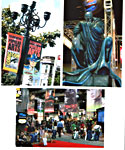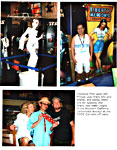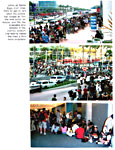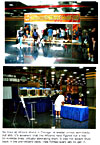 |
||||
|
Opus 189:
Opus 189 (August 15, 2006). Our hare-razing report on the San
Diego Comic-Con is featured this time, with a passing footnote on the Wizard
World Con in Chicago. We also drop the other shoe and tell you what really
transpired at the Reuben presentation ceremony during the National Cartoonists
Society’s annual fandango in Chicago in May. Here’s what’s here, in order:
NOUS R US
National
Cartoon Museum Gets Big Grant
Movie
Box Office Race
Beavis
and Butt-head
Kerouac’s
on the Road
Top
10 Graphic Novels
Mickey
Spillane Dies
Political
Clout of Cartoons Overseas
Kal’s
Show
50
Sidekicks (with a couple omissions)
Paid
Product Placement in Funnybooks
Ted
Rall’s New Gig
Playboy
in Indonesia
Bob Thaves Dies
How to Win the War on Terror
Re-visiting the Reuben
BOOK MARQUEE
EC
Archives in Color
On
Stage at Last
Coming
Reprints from Andrew McMeel
COMIC STRIP WATCH
Scott
Adams gets Hitched
Political
Edginess Earns Notice
The Sandy Eggo Con
The Wizard Con
Bush
the Joke
And
our usual reminder: don’t forget to activate the “Bathroom Button” by clicking
on the “print friendly version” so you can print off a copy of just this
lengthy installment for reading later, at your leisure while enthroned. Without
further adieu—
NOUS R US
All the news that gives us fits.
The National Cartoon Museum is gathering
the monetary momentum it needs to open in the Empire State Building in New York
City. The City’s Department of Cultural Affairs and the City Council together
have committed $1.8 million to the Museum’s development. In announcing the
grant, Commissioner Kate D. Levin of Cultural Affairs said: “Cartoon art is a
multidimensional, evolving form of expression. It covers everything from the
funnies to graphic novels to the inspiration behind popular television and movies. Mort Walker [Chairman and Founder of
the Museum] has been a pioneer in institutionalizing this beloved art form. In
bringing it to New York, he and his colleagues have an opportunity to create a
wonderful new participant in New York’s cultural community.” This grant brings
to $2.165 million the funds raised to open the Museum. Anyone wishing to donate
to The Cause can send checks to The National Cartoon Museum, 350 Fifth Avenue,
Suite 3304, New York, NY 10018-0069. Those who make a commitment of $1,000 or
more annually in the Museum’s first three years will be recognized as Friends
of the Museum. For more information, contact Stephen Kiviat, the Museum’s
director, at 212/689-1093 or shk@cartoon.org.
No doubt the great mass of humanity
has long been aware of the phenomenon that, only now, is edging into my
consciousness—namely, the tendency in entertainment news coverage to treat
movie openings as horse races with box office receipts determining who is
winning. When “Superman Returns” opened the weekend before Tuesday’s July 4th, it raked in $52.5
million, or $84.6 million since its opening on the previous Wednesday. This
five-day weekend take was compared, unfavorably, to the four-day Memorial Day
weekend opening of “X-Men: The Last Stand,” which toted up $122.9 million.
“Superman” was a disappointment: with a budget of more than $250 million, it is
one of the most expensive movies ever, and it was expected to bring in between
$55 and $80 million over its inaugural weekend. It didn’t. Then along came “Pirates of the Caribbean: Dead Man’s
Chest,” Johnny Depp’s vehicle, which blew away most previous revenue
records: in its first three days, it took in $132 million, shattering the
previous record of $114.8 million held by 2002's “Spider-Man”; “Pirates” was
also the first film to haul in $100 million in two days, pulling $55.5 million
on Friday and setting a new single-day record by surpassing $50 million set by
“Star Wars, Episode III: Revenge of the Sith” last year. “Pirates” led in box
office receipts record for the next two weekends, and by its 16th day in release, it had earned $321.7 million, making it the fastest film in
box-office history to pass the $300 million mark. “Sith” took 17 days last
year. The summer’s other block-buster releases faltered: “X-Men” hit $224.5
million in its fifth week; “Da Vinci Code,” $205.6 in its sixth week. In this
race, the 6th place standing of the modest “Over the Hedge” animated
film with $144.7 million after 6 weeks is notable; Disney/Pixar’s “Cars” ranked
5th , just ahead of “Hedge,” in 2006's Top 20 chart in Entertainment Weekly. “Superman,”
meanwhile, has dropped off the chart altogether. Pondering all these numbers,
I’m persuaded that the movie industry has supplanted baseball as the national
game of statistics.
Jason Silverman at wired.com was
disappointed with “Superman Returns.” The
movie pits the technocrat Lex Lurther against Supeman, “a faith-based guy,” but
does the movie “give us a juicy faith-versus-science battle?” Silverman asks.
“No such luck,” he answers. “Filled with big ideas that never quite gel and
spiked with suggestive [Christ-like] imagery that ultimately feels meaningless,
Bryan Singer’s film floats from one gorgeous scene to another without quite
connecting the emotional or narrative dots.” Moreover, “Kate Bosworth’s Lois is
a fraction as scrappy, resourceful and quick-witted as Teri Hatcher’s or Margot
Kidder’s”; and newcomer Brandon Routh as the Man of Steel, “despite his perfect
superhero chin and cheekbones, wears so much make-up that he looks like the Man
of Plastic.” But Silverman gives the movie points for its flying scenes and its
“strong sense of place.” Most of the reviews of “Pirates” said Depp ran away
with the movie, making entertainment out of otherwise nearly meaningless
special effects spectacle. Then, along comes “My Super Ex-Girlfriend,” an
“oddly inspired” concept in which, as Robert Koehler said in Variety, “a female superhero is not only
able to stop crime and save the planet but was also neurotic, possessive, and insanely
jealous.” This’ll be Uma Thurman’s movie, I’d guess, like “Pirates” is Depp’s.
We’ll see. We may also see, eventually, an animated film from Warner Bros that
brings the Justice League of America to the big screen.
MTV, which, for some, embodied mindless
television programming as “Empty-Vee,” turned twenty-five on August 1 and
reminded us of that 1980s phenomenon, the animated champions of unutterably bad
taste in all things, Beavis and Butt-head, who debuted on the new network on
March 24, 1984. The pilot tape showed the two hopelessly callous adolescents
playing baseball with a frog. Producer Toffler said he watched it 100 times.
“You have a feeling in your bones that there’s something different about it
that’s unique and it will either flop miserably or succeed brilliantly.”
Stupid, gross-out comedy, but we couldn’t look away. Volume 3 of the 3-volume
DVD set is out: 42 cartoons, including 24 that haven’t been released on DVD
before, “the uncut, original short ‘Frog Baseball,’ music videos and more” at www.beavisandbutt-head.mtv.com
I met Rick Parker, who drew the comic book version of Beavis and
Butt-head, at a Chicago Comic Con in the 1980s, and we once sat gleefully
together in Artists Alley. An outrageously satiric personality, Rick sold
everything at hand to his famished fans, sketching Beavis and Butt-head to a
fare-thee-well. Once he turned to me with a marker in his hand and said: “This
marker is completely dry and worthless. Watch me sell it to someone.” He wrote
his name on the shaft of the marker with another marker and sold it for five
bucks to the next person who came up to the table. Such is the fanaticism of
Beavis and Butt-head devotees.
Jack
Kerouac’s beatnik bible, On the Road, will be published in its unedited original form at the end of next year,
celebrating the 50th anniversary of the novel’s initial publication.
Kerouac typed the book on long sheets of tracing paper and taped them together
to create a lengthy rolling scroll of text. The anniversary edition will
apparently reproduce this text in paginated form, including passages that were
removed by the publisher but still excluding paragraphs Kerouac had crossed out
before sending the typescroll off to Viking in 1957. I mention this for purely
sentimental reasons. I typed my term papers in college using the same
technique. I inserted one end of a roll of teletype paper into my typewriter
and copied quotations out of source books. When I had eight linear feet, I tore
off the sheet, cut the quotations apart, arranged them in what appeared to be a
logical order, and typed them all again on sheets of 8x11-inch paper, this time
supplying connecting text to string the quotations together. This method
invariably produced a 12-page term paper, precisely the length prescribed.
Whether I picked this technique up from Kerouac or not, I can’t remember. But I
read the novel in the summer of 1958. A friend of mine at the time, a piano
player named Lee Underwood, read the book at a single sitting, then packed a
suitcase, and left town, hitch-hiking across country. I never saw him again.
Entertainment
Weekly (July 14) cited sales at Los Angeles’ Golden Apple comic book store
to assemble a list of the top ten graphic novels, from 1 to 10: DMZ Vol. 1, Invincible Vol. 8, Hellboy Vol.
6, Power Girl, Fear Agent Vol. 1, Conan Vol. 3, Star Wars: Omnibus Vol. 1, Sin
City Library Set 2, Stupid Comics Vol. 1, and She-Hulk Vol. 3. Well, maybe;
maybe not. This list seems to be mostly reprint compilations of individual
issues of one comic book series or another. None, in other words, written as
“graphic novels,” unified, single-issue narratives between one set of covers.
Until we clear up this confusion about what constitutes a genuine graphic
novel, we’ll have to endure more such phoney tallies as this.
Mickey Spillane died on July 17 at
his home at Murrells Inlet, South Carolina. Spillane’s books about his
hard-bitten private eye hero, Mike Hammer, were nearly required reading for my
generation during adolescence: we learned a good deal about sexuality from his
books. Later, I could see that his combination of brutal action and bosomy,
leggy women united sex and violence in a pure Freudian dream. His books never
won much praise from literary critics, but Max Allan Collins, author of Road to Perdition (among others), is
right: “Spillane’s the one who kicked down the sex and violence doors. He
changed pop storytelling. You don’t have Dirty Harry or James Bond without Mike
Hammer.” Spillane’s place of residence, when I learned of it, fascinated me
because of a coincidence: I used to go to Drunken Jack’s, a restaurant on the
water there, where the hush puppies were delicious and the view restful. Never
saw Spillane there though.
Since the advent of the Danish Dozen, news outlets have paid a
little more attention than before to cartoons. The New York Times, f’instance, reporting the change in Arab opinion
from revulsion to over support for Hezbollah’s incursion into Israel, cited,
among other evidence, “a cartoon by Emad Hajjaj in Jordan labeled ‘The New
Middle East’ [that] showed an Israeli tank sitting on a broken apartment house
in the shape of the Arab world.” ... The Anti-Defamation League recently issued
a report entitled Flashpoint Lebanon: The
Arab Media’s War of Incitement, which goes to considerable length to show
that Arab newspapers are publishing a spate of particularly nasty anti-Semitic
cartoons, deploying the time-worn hook-nose caricatures and other tattered
stereotypes, to “stir the pot of hatred of Israel and Jews in the Arab street.”
... Major General Robert Scales (Ret.), writing about the proposed flag burning
amendment in Time (July 3) urged Congress to “Forget flag burning: debating a ban during war is a waste of time and
sends troops the wrong message.” This is not the time for “such tertiary
considerations,” he said. Then he quoted his first sergeant in Vietnam, who had
served in two wars. “He gave me a piece of advice then that Congressmen intent
on changing the subject should heed: ‘In combat, the main thing is to keep the main
thing the main thing. Otherwise, you die.’ The main thing today for Congress
and the nation should be the war in Iraq. Soldiers are sworn to defend the
right to free speech with their lives even if ‘speech’ is expressed in
despicable ways. What they want in return is the assurance that our lawmakers
will hold their interests dear. So the message from most of us soldiers is
clear: debate a flag-burning amendment if you wish. But don’t create the
perception among our young men and women in combat that there are more
important issues than their welfare at the moment.”
At the Walters Art Museum in
Baltimore, a retrospective exhibit of the editorial cartoons and other art
works of Kevin Kallaugher (“Kal’), who took a buy-out last winter rather than to be shoved unceremoniously out the
door of the Baltimore Sun, has
attracted over 5,000 visitors since opening on June 18; it will close September
3. Kal’s new book collection, Kal Draws
Criticism, was published in conjunction with the exhibition and includes “my
best cartoons,” he says, from The
Economist and the Sun, “including
16 pages in color.” More at www.kaltoons.com. ... The animated Boondocks: The Complete First Season DVD
ranked 7th on the VideoScan list of best-selling DVDs (by units) for
the week of July 30. The only tv-related release that did better was Chappelle’s Show: The Lost Episodes. Aaron McGruder’s comic strip-based
series was renewed last winter for a second season on the Cartoon Network even
before all the inaugural season’s shows had aired. ... Don Fraser, a former
Peanuts licensee, and Derrick Bang, Entertainment
Weekly made up a list of the 50 “greatest
sidekicks of all time” for its July 21 issue, and among them are a few
fugitives from cartoon universes: after Number One, Ed McMahon, comes Robin at
Number Two (although he’s depicted by a movie actor, not a comic book
character); at Twelve, we start getting animated second bananas with Shrek’s
Donkey, then Waylon Smithers from “The Simpsons” at Sixteen, Gromit at
Twenty-One, Barney Rubble at Thirty-four, and Jimmy Olson at Forty-three.
Funny: as a youth devouring funnybook fantasies in the late 1940s and early
1950s, I never thought Jimmy Olson was a very significant figure, certainly
nothing approaching a sidekick. Two cartoon characters are mentioned among the
“inanimate sidekicks”: Harold’s purple crayon and Calvin’s stuffed tiger,
Hobbes. But Dick Tracy’s two-way wrist radio isn’t mentioned. Don Quixote’s
Sancho Panza is slotted at No. 14, but the most famous sidekick of all, the
Lone Ranger’s Tonto, is overlooked entirely. If generational myopia doesn’t
triumph, ethnocentrism will.
The contagion spreads: comic books
are doing paid product placement. DC’s Rush City series was concocted
as a showcase for the General Motors’ Pontiac Solstice GXP, said Kortney
Stringer of the Detroit Free Press. Marvel, on the other hand, didn’t create a new series to make the new Dodge
Caliber compact visible: pictures of the auto will simply be woven into various
existing books by the end of the year. “In the past, Marvel has done paid
placements for Nike, Schwinn and Sony, where their logos appeared in places
such as T-shirts and billboards in comics”—wherever deemed appropriate by
editors, said Dan Buckley, Marvel publisher. Dodge maintains such product
placement in comics is “a no-brainer” because Marvel’s circulation overlaps
with the Caliber’s target demographic, “a difficult audience to reach,” said
Mark Spencer, a Dodge spokesperson.
Speaking of resources, here’s
something called Provisions Library, which can be visited at the Provisions Library Blog. Once there, click on the
Newsletter, and you’ll find a list of such things as a history of racial and
ethnic diversity in the history of comics, or graphic novels, or political
cartoons. The Provisions Library was initiated in about 2001 by the Gaea
Foundation (which is what, I dunno) “to find effective ways to nurture creative
individuals engaged in radical social change.” Could be anyone, I suppose. But
I wound up wandering the racial and ethnic strand of comics history,
interesting if sometimes telescoped enough to be slightly misleading. ... That
controversial episode of “South Park” that
was pulled from the broadcast schedule in March because it skewered Scientology
and its most visible proponent, Tom Cruise, was rotated back into the broadcast
schedule in July, reportedly airing on the 19th. Comedy Central
rotates the 150 South Park episodes in and out of a broadcast schedule all year
long; the episode in question had debuted some time ago and was due for
rotation last winter, but because Comedy Central didn’t want to offend Cruise
(who might have declined to promote his third “Mission Impossible” movie in
retaliation), the rotation was sidetracked. Now it’s back. “If they hadn’t put
this episode back on the air,” said Matt
Stone, one of the show’s co-creators, “we’d have had some serious issues,
and we wouldn’t be doing anything else with them.”
Ted
Rall, tooner gadfly, radio personality and syndicated columnist, has joined
United Media to acquire and develop comic strips, cartoon panels and text
columns for United’s two syndicates, United Feature and Newspaper Enterprise
Association. Said Rall: “I am looking forward to the opportunity to help
newspapers connect with new readers and to bring the exciting work of America’s
best writers and cartoonists to a wider audience.” Translated, that means he’ll
be scouring the alternative media landscape for the kind of talent that will
attract young readers to newspapers. Rall seems perfectly poised for the
assignment, having produced several books lately with NBM that survey alternate
cartoonists. We suspect United’s line-up will soon be a good deal more edgy
than anything it’s offered so far. Either that or we’ll read that Rall has
resigned because they aren’t willing to take the kinds of chances that he will
surely be lobbying them to take. Rall’s cartoon and column will continue in
syndication at Universal Press, a rival operation; but Rall sees no reason to
discontinue a long and mutually satisfying association. As for edginess, in a
recent column, Rall examined the U.S. military’s ready resorting to aerial
bombardment “in lieu of deploying infantry troops on the ground.” Troops on the
ground can better identify what to shoot at—thereby reducing the likelihood of
collateral damage among the civilian population—but they expose themselves to
risk. American, Israeli and other Western militaries prefer to minimize risk to
their own troops and rely upon bombs to do the work, at the same time,
perpetuating the fiction that they (a) have access to reliable intelligence and
(b) use reliable intelligence to target their bombs and missiles with uncanny accuracy,
thereby virtually eliminating civilian casualties. But “aerial projectiles
consistently fail to deliver,” Rall points out, citing examples of civilians
killed by misguided missiles. Despite persistent spin to the contrary, pinpoint
bombing isn’t pinpoint accurate at all. But we continue to do it, Rall says,
because “we value the lives of our troops a lot more than those of civilians in
other countries. We’re willing to slaughter them en masse in order to minimize
casualties among our own.” Probably true and certainly understandable; but we
wish it were otherwise.
Playboy, as I mentioned here some
while back, is publishing one of its overseas editions in Indonesia, the
world’s most populous Muslim country. The strict morality of Islam, one
supposes, would doom Playboy’s enterprise from the start, but with an indigenous editor, the magazine reached
its third issue last month. In deference to local custom, the first issue
included no photographs of barenekkidwimmin. No nudity at all. At least in
photos; my source, The New York Times, said nothing about cartoons, though—a strange omission in a magazine renowned
for its cartoons. In the first issue’s main photograph, the traditional
centerfold model appeared in a modest negligee. Lots of leg but no other epidermis
to speak of. Ensuing issues have been no more daring. Goenawan Mohamad, the
founder of an Indonesian newsweekly and a distinguished columnist, sniffed that
the magazine was so tame that it would be absurd to ban it. Still, the editor,
Erwin Arnada, was arrested, questioned, and charged with violating the
indecency provisions of the criminal code. By unhappy coincidence, the magazine
hit the newsstands while the government was debating an anti-pornography law.
At the heart of the matter is the fear about the intrusion of Western culture
with the permissiveness Muslims see everywhere in the West. Meanwhile, an
Indonesian magazine, Red Light, continues to publish on crude newsprint, carrying advertisements for
prostitutes and their phone numbers, photos of naked men and women, and
sexually provocative headlines. All of which proves, if it needs proving, that
hypocrisy is human and universal among the species; it is not, as I’d supposed
all along, confined to the neoconservative wing of the Republican party or to
just the elected members of our government.
Fascinating
Footnote. Some of the news
retailed in this segment is culled from articles eventually indexed at http://www.rpi.edu/~bulloj/comxbib.html, the Comics Research Bibliography, maintained by Michael Rhode and John
Bullough, which covers comic books, comic strips, animation, caricature,
cartoons, bandes dessinees and
related topics. It also provides links to numerous other sites that delve
deeply into cartooning topics.
FRANK
& ERNEST CREATOR BOB THAVES DIES AT 81
From United Media
Bob
Thaves, creator of the single-panel comic strip Frank & Ernest, died August 1 in Torrance, California. He was
81. For more than three decades, since 1972, Frank & Ernest perpetrated a hilarious brand of off-the-wall
humor, delighting millions of readers daily with twisted phrases and skewed
outlook and wonderfully terrible puns. Distributed to more than 1,300
newspapers worldwide, the strip stars Frank and Ernest, playful punsters who
appear in any role and at any moment in history that their joke that day
demands. The constant element is the pair's "frank and earnest"
iconoclastic attitude.
Thaves was a three-time winner of
the National Cartoonists Society's Reuben Award for Best Syndicated Panel and
was given the Free Press Association's Mencken Award for Best Cartoon. He was
voted "Punster of the Year" by the International Save the Pun
Foundation and just this year was recognized as a Champion of Creativity by the
American Creativity Association. A true innovator, he invented his Frank & Ernest as the first comic
panel presented in a strip format. It was the first to vary the roles of its
characters and the first to use block lettering. It was also the first to use
comic book-style digital coloring for the Sunday pages. Frank & Ernest was one of the first comic strips to have its
own Web site, www.frankandernest.com, which has included several
innovative components, including the first 3-D interactive comics based on a
comic strip. Thaves, who held both bachelors and masters degrees in psychology
from the University of Minnesota, began cartooning as a kid and never stopped.
He created Frank & Ernest while
working as a consultant in industrial psychology in California.
In announcing Thaves’ death, Katie
Thaves, the cartoonist’s widow, and Sara, his daughter, as well as his son Tom
took pains to acknowledge the contributions to the strip of Tom Peoples, NEA’s
editor “who was willing to take a chance
How
to Win the War on Terror
It
is now commonly agreed that the Bush League’s foray into Iraq has been, from
the very beginning, an unmitigated and unquestioned disaster, a triumph of arrogance
and ignorance over common sense and common decency. From the very start, we
displayed a criminal lack of knowledge about Arab culture. Had we any inkling
of it, we would have recognized that Saddam’s reputed store of weapons of mass
destruction was but a macho pose of the sort nomadic cultures have fostered for
centuries. Saddam achieved status among other Arab nations by standing up to
the Great Satan in the West, the United States—by flaunting a military might
that was almost entirely fictional.
We continued making the same
mistakes of arrogance and ignorance almost as soon as we had boots on the
ground in Iraq. In the July 31-August 6 issue of the Washington Post National Weekly Edition, Thomas E. Ricks examines
further “the early missteps that left U.S. troops unprepared to fight the Iraqi
insurgency.” The biggest misstep of all, he says, is the failure to realize
soon enough that we were fighting a guerrilla war. “Vietnam’s lessons were
ignored.” Ricks unearths “one of the essential texts on counterinsurgency, Counterinsurgency Warfare: Theory and
Practice, a 1964 volume written by David Galula, a lieutenant colonel in
the French army who had witnessed guerrilla war on three continents. The book,
Ricks says, was, until recently, virtually unknown in U.S. military circles,
“which is one reason it is possible to open Galula’s text almost at random and
find principles of counterinsurgency that the American effort failed to heed.”
Among them, the American conviction that the Iraqi civilian population was a
sort of “playing field on which a contest was played against the insurgents”
when the opposite is more accurate: “the people are the prize. ... ‘The
population becomes the objective for the counterinsurgent as it was for his
enemy.’ From that observation flows an entirely different way of dealing with
civilians in the midst of a guerrilla war. ‘Since antagonizing the population
will not help, it is imperative that hardships for it and rash actions on the
part of the forces be kept to a minimum,’ Galula wrote.” Ricks refers to a
course in military strategy taught at Fort Leavenworth’s School of Advanced
Military Studies which has determined that the U.S. experience in Iraq in
2003-2004 is remarkably similar to the French war in Algeria in the 1950s. “Both
involved Western powers exercising sovereignty in Arab states, both powers were
opposed by insurgencies contesting that sovereignty, and both wars were
controversial back home. Most significant [is the fact that] both the French
and U.S. militaries were woefully unprepared for the task at hand. Currently,
the U.S. military does not have a viable counterinsurgency doctrine, understood
by all soldiers, or taught at service schools.” Galula’s book, however, is at
last a bestseller at the Leavenworth bookstore. Perhaps too late.
Meanwhile, in the current battle
between Israel and Hezbollah, we are likely, in our perpetual arrogance, to
overlook the most significant aspect of the encounter. At first, the so-called
moderate Arab states in the neighborhood condemned Hezbollah for precipitating
the crisis. Then, as the Hezbollah militia held out successfully against the
military might of Israel, opinions changed. Within days, Hezbollah was being
cheered in the Arab streets. In this development, we see the predicament of the
region in stark outline. Hezbollah has not won anything on the battlefield: it
has merely withstood, albeit momentarily, the onslaught of one of the world’s
most sophisticated military machines. Yet even in that momentary resistance,
Arab countries find something to cheer about, a sort of illusion of victory.
Only in a culture that suffers from a nearly paralyzing inferiority can such a
trifling achievement be viewed as a triumph. The sense of national deprivation,
the loss of cultural pride, that has festered in Arab nations since the
collapse of the Muslim empire in about 1200-1400 is almost entirely responsible
for the recruiting success of the 21st century terrorist movement.
Deep down, the appeal is to a completely disenfranchised people, particularly
the young and underemployed who have no hope. The terrorist movement holds out
hope—the hope that the magnificence of the caliphate of storied yore can be
restored by adhering strictly to the principles of the religion Muhammad
founded. The chronic problems of this wartorn region will not be solved until
the referees, the U.S. and European nations, find a way to revive Arab pride.
Ultimately, it cannot be done by imposing, through military force, a so-called
peace: it can be done only if the Arabs are the active agents. The culture will
then take pride in its own achievement, and when Muslim pride is restored, the
terrorists will find no more candidates for the ranks of its suicide bombers.
CIVILIZATION’S LAST OUTPOST
One of a kind beats everything. —Dennis
Miller adv.
Mitt
Romney, the Republican governor of Massachusetts, quotes his wife when
describing the gridlock in Congress: she likens the spectacle of Congressional
action to “two guys in a canoe that is headed for the falls, and all they do is
hit each other with their paddles.”
RE-VISITING THE REUBEN
My
exhaustive (not to say tedious) report in Opus 185 on the Reuben Weekend
of the National Cartoonists Society began, you’ll recall immediately without
further prompting, with this passage:
“Congratulations,” I said to Mike Luckovich, shaking his hand
warmly, “—on winning the Chester Gould Reuben.”
“Oh, you heard?” he said. “Well, I’m
not giving it back,” he quipped with a grin.
I promised then to explain this
cryptic exchange at a future time, and that time has now hove over the horizon.
Another of your recollections of that epic Opus 185 may be that on Sunday, the
day after the Reuben Banquet, I and a tiny (two-man) band of brethren made a
50-mile trek to Woodstock, Illinois, home of Chester Gould, creator of Dick Tracy, where we visited the Dick
Tracy Museum as an act of homage to the 75th anniversary of the
strip this year, an event also celebrated “Excitement?” I said.
“Yes,” he continued. “Apparently
they lost or misplaced the Reuben statuette, and since they had to have
something to give the winner, they borrowed one of Gould’s for the purpose.”
“Oh?” I said. “How did that happen?”
“I don’t know how the statuette
turned up missing,” he said, “but they knew that Gould had two of them, and his
daughter was attending the convention—part of the 75th anniversary
festivities—so they asked if they could borrow one of them for the
presentation. Her son, Tracy O’Connell, made the trip up to Geneva, where she
lives now, and brought one of them back to Chicago for the presentation
ceremony.” He chuckled. “Almost didn’t get there. He stumbled getting out of
the car and almost dropped the thing.”
That’s the tale I would’ve told had
I not been prevailed upon by NCS president Rick
Stromoski to hold my tongue until he had a chance to tell what “really
happened” in the next issue of the NCS Cartoonist, which arrived a week or so ago and contained a full report on the Reuben
Weekend. What “really happened,” according to Stromoski, is that the
manufacturer of the Reuben trophy and the plaques for each of the “division
awards” had failed, apparently, to include the Reuben in the shipment with the
other awards that it sent to Chicago. The company has been faithfully making
the Reubens and the plaques for nearly 60 years, and this was the first time in
memory that it had goofed so spectacularly. Another historic first for the
Chicago convention. Alas, it happened on Stromoski’s first Reuben Weekend as
NCS president. Since one of the chief functions of the NCS president is to
arrange this annual party, he was, understandably, anxious that it all go well.
And then this happens. He didn’t learn of the missing trophy until Saturday
afternoon, just four hours before the banquet at which the Reuben would be
presented. (Hereafter, we may suppose that the box of awards shipped from the
manufacturer will be opened and the contents verified somewhat earlier in the
weekend—for no other reason than to give the rescue squad a little longer to
concoct a rescue maneuver.) Naturally, Stromoski was apprehensive about how
news of this mishap would come out: as the responsible party in the NCS
hierarchy, he knew he would be blamed—and rightly so, pro forma at least; he was, after all, in charge of the weekend’s
arrangements. But he was scarcely the culprit. No one, really, was: it was as
much accident as oversight, and both were committed by the manufacturer, not
Rick. When he learned that I knew about the missing Reuben, he asked me to
forego the journalistic (not to say fiendish) pleasure of breaking the
scandalous tale and let him do it in his own way. Which I did, more-or-less;
and he did, too, regaling us with the horrendous facts in the May-June issue of
the NCS newsletter.
“I had a nagging feeling that my
first Reuben weekend as NCS president was going a little too smoothly,”
Stromoski wrote. And then shortly after 2 p.m. on Saturday, his “worst fear”
was confirmed: no Reuben statuette. Past president Steve McGarry is apparently the resourceful factotum who conjured
up the solution to the predicament, guessing that there had to be someone
else’s Reuben trophy somewhere within driving distance. And then they all
thought of Jean O’Connell, Gould’s daughter, who was at the convention to
conduct a short remembrance of her father. When Stromoski described his dilemma
to her, “she jumped at the chance” to supply one of her father’s Reubens as a
stand-in. She was, Stromoski said, “very excited that her dad could help the
NCS one last time. I put her son Tracy and son-in-law Brett into a limousine
for the two-hour round trip to Geneva. As they got ready to leave, Jean told
her son, ‘Make sure you get the shiny one.’” NCS changed the formula for the
metal between Gould’s first Reuben in 1959 and his second in 1977: the earlier
substance tarnished pretty fast.
And now, I trust that my cryptic
exchange with this year’s Reuben winner is fully decoded. And that Stromoski
emerged unscathed despite the yellow journalism that usually oozes from every
pore of Rancid Raves.
Quips & Quotes
“I
really don’t think I need buns of steel. I’d be happy with buns of cinnamon.”
—Ellen DeGeneres
“The need of exercise is a modern
superstition, invented by people who ate too much and had nothing to think
about. Athletics don’t make anybody either long-lived or useful.” —George
Santayana
“I am pushing sixty. That is enough
exercise for me.” —Mark Twain
“I’ve been on a constant diet for
the last two decades. I’ve lost a total of 789 pounds. By all accounts, I
should be hanging from a charm bracelet.” —Erma Bombeck
“My doctor told me to stop having
intimate dinners for four. Unless there are three other people.” —Orson Welles
“Where do you go to get anorexia?”
—Shelly Winters
“When I buy cookies, I eat just four
and throw the rest away. But first I spray them with Raid so I won’t dig them
out of the garbage later. Be careful, though, because Raid really doesn’t taste
that bad.” —Janette Barber
“Never eat more than you can lift.”
—Miss Piggy
“What Orson Welles was to movies,
what Milton Caniff was to comic strips, that’s what Will Eisner was to the
comic book medium.” —Michael Uslan
“All things pass away, but if you
live your life well, everything is fun while it lasts.” —from Roger Ebert’s
review of “A Prairie Home Companion,” which the critic loved without stint or
quibble.
BOOK MARQUEE
Herewith,
a few notes in passing on notable projects either in hand or a-borning. Russ Cochran, who pioneered quality
comic book reprinting with his stunning black-and-white “library” of EC Comics
twenty years ago, is at it again: this time, with the EC Archives, in which he re-issues the EC Library but all
in color—with new, definitely superior, color separations. And if you
act before October 31, the first two volumes, 8x11-inch 212-page hardcovers,
reprinting six issues each from Weird
Science and Shock SuspenStories, are available at $30 each instead of the usual $49.95. For details, visit
eccrypt.com or russcochrancomicart.com.
Just launched, a new reprint project
with Leonard Starr’s On Stage, that
exquisitely illustrated absorbing story of Mary Perkins, a country girl who
comes to New York to pursue a theatrical career. The first volume (162
8.5x11-inch pages, b/w in paperback, $19.95) starts at the beginning of the
strip on February 10, 1957, when Mary arrives in the Big Apple, already,
unbeknownst to her, the victim of a scam. By the end of this book, on January
11, 1958, Mary has escaped the scam and the attentions of a mad actor and has
attracted the interest of several important persons who determine to advance
her career. She’s also met and fallen in love with the photographer, Pete
Fletcher. I hadn’t remembered that this happened this early. Happily for the
sake of perpetrating suspense, the course of their true love is fated to be
somewhat bumpy: this volume ends with them going off in separate ways in
pursuit of their careers. Otherwise, the strip celebrates the hoary show biz
myths of overnight stardom and celebrity, a fairy tale but told here with
engaging inventiveness and beautiful pictures. Starr’s detailed artwork is
reproduced with exacting care (only a very few flubs, and those, not enough to
undermine the over-all satisfaction of reading and viewing the volume). Volume
Two is due in November. Both can be ordered at www.classiccomicspress.com or by sending your check for $19.95 plus p&h of $3.95 ($23.90 total) to
Classic Comics Press, 55 West Chestnut Street, suite 2908, Chicago, IL
60610-7321.
Titles on the horizon from Andrews
McMeel, the industry’s premiere publisher of comic strip reprints: A Million Pieces of Close to Home (John
McPherson’s Close to Home), Let’s Get Pickled (Brian Crane’s Pickles), Bad Habits (Glen McCoy’s The Duplex), Try Rebooting
Yourself (28th Dilbert collection by Scott Adams), Bevity (a
new single-panel strip by Guy Endore-Kaiser and Rodd Perry), Lions and Tigers and Crocs, Oh My (including
a section of “banned” strips from the always scornful Stephan Pastis’s Pearls Before Swine strip), Another Stereotype Bites the Dust (the
second volume of Darrin Bell’s Candorville),
Are We Out of the Driveway Yet? (Jerry Scott and Jim Borgman’s Zits). Also a-borning, this time from Harry N. Abrams, Cartoon America: Comic Art in the Library of Congress, a 324-page
tome edited by curator and comics historian Harry Katz (which includes, I
hasten to add, a few paragraphs from moi).
COMIC STRIP WATCH
Bill
Amend’s FoxTrot joined the cross-over
crowd the week of July 24. Jason, the strip’s resident genius and aspiring
cartoonist, notices that “another cartoonist is running re-runs while on
vacation” and undertakes to supplant the re-runs with strips of his own devising
that ape the originals. In this cross-over I find none of the scorn that often
permeates those in Pearls before Swine. Jason’s strips, it turns out, all make fun of his older sister, Paige, and the
comedy of the whole series is therefore well within the mythos of Amend’s
universe: he is not, in other words, ridiculing the strips whose characters he
has momentarily appropriated. Traveling around the country last
month, I sampled newspaper comic strip line-ups in various cities. The Los Angeles Times runs 26 strips and 10
panel cartoons for a total of 36. The San
Diego Union-Tribune publishes 38 strips and 4 panels for a total of 42, yet
its circulation area is less populous than the L.A. Times’; you’d think the Times would be running more strips, as would, seemingly, befit a paper with its
large circulation. The San Jose Mercury
News runs 28 strips and 3 panels; total, 31. The neighboring San Francisco Chronicle runs 20 strips
plus 2 panels, totaling 22. The Dallas
Morning News offers 35 strips and 7 panels, totalling 42, another
satisfying line-up in both quantity and quality. The Dallas Morning News, by the way, like most daily newspapers, is
seeking to “meet evolving reader and consumer needs,” which, as with other
newspapers, involves reducing staff: in this case, 85 newsroom jobs will be
eliminated, the News offering
severance packages to “those who may prefer another work environment” (an
environment that, apparently, would include them). Most of the papers in my
informal survey run For Better or For
Worse, Peanuts, and Doonesbury; but the soap-opera stalwarts are, apparently, fading. Rex Morgan is in a couple of these papers; Judge Parker in a couple. No Mary
Worth or Apartment 3-G.
The International Herald Tribune, the last vestige of two grand old
names in American newspapering, now inhabiting Paris rather than any American
city, declined to run Wiley Miller’s Non Sequitur for Friday, August 11. The
strip is part of a week-long sequence in which the precocious tot Danae finds
herself in a parallel universe, one in which, as it develops, “everyone is
granted one wish.” Explaining all this to Danae is a look-alike little girl
named Danae. On Thursday, August 10, the latter points to a man who “was a
strict Constitution originalist on the Supreme Court and wished to have all the
amendments removed.” The man, we learn, is named Clarence and is owned by
Antonin Scalia, who “made the same wish.” Then on Friday, the two girls
encounter a woman in a burqa, who, the Danae clone says, is Ann Coulter, who
“wished to get rid of everything liberal in her life.” At the International Herald Tribune, deputy
features editor Judy Burtt explained the paper’s dissatisfaction with the
strip: “We felt it was obscure to many of our international readers as well as
potentially offensive to some of them.” Wiley, while noting that it’s “the
right—even the obligation—of every editor to run or censor anything” in their
paper, observed: “Under the reasoning they’ve stated, every cartoon could be
deemed inappropriate.” Right: possible “obscurity” of a joke or its “potential”
for offending pretty much captures the universe of comedy. At the Daily Record, a reader wrote in to protest the July 19 Lio strip. This installment of the
strip, a pantomime endeavor by Mark
Tatulli (see Opus 186), shows the title character, a young boy, with
his father in the pet store, happily purchasing a puppy, which, once the kid
gets home, is gift-wrapped as a present for his gigantic pet snake. This
gruesome gag (you should pardon the expression) the reader, Dorothy Hall, found
horrifying. “Don’t you realize how many young people read the comics? You are
telling them it is okay to torture and destroy one of God’s creatures. I know
you will say that it is not pictured that the giant snake eats the puppy, but
our young people have good brains and can figure it out.” If they’re all that
smart, surely they know the strip is a joke, albeit one steeped in dark humor
of the macabre sort that kids delight in.
Finally, celebrating weird coincidence, here are three strips, which, in my local newspaper, appear on the comics page just as they appear here, all telling jokes in which spraying water is the McGuffin.
The Wit and Wisdom of Madeleine
Albright, Former U.S. Secretary of State
“I’m
not a person who thinks the world would be entirely different if it was run by
women. If you think that, you’ve forgotten what high school was like.”
Albright, who confesses to being a
prude (“and I’ve always been a prude”), disapproves of current feminine
fashions that result in flashes of female flesh, like Jennifer Aniston’s tummy,
for instance. “If you dress like a sex object,” saith Albright, “you’ll be
treated like one.” Makes sense to me. But her most serious objection to such
fashions stems from her belief that the people of other nations develop
unfavorable views of the United States from the midriffs they see flaunted
hither and yon.
SAN DIEGO COMIC-CON INTERNATIONAL
The Mob Scene at the San Diego Revel
for Comic Book Fans
The
37th annual San Diego Comic-Con International, the country’s oldest
orgy of comic book character culture, is more about lines than about comic
books or movies or television or gaming or toys, dolls, and costumes. Lines
drawn on paper, of course, but at the Con, the lines are also humanoid, and they fill the aisles. The
visual and aural excitement of the Thursday-Sunday revel was almost enough to
persuade you to overlook the perpetual line. Lines filled every square foot of
floor space in the gigantic 460,000 square-foot Convention Center, a sprawling
cavern 5-6 blocks long right on the waterfront. People lined up to get in: even
if they’d preregistered, they had to line up to get their name badges. The
lines began forming hours before the daily 10 a.m. opening; they stretched the
length of the Center and around the corner and down the block. And they lasted
all day long from before dawn until late in the afternoon, through some of the
hottest days of the summer; temperatures on Saturday reached 99 degrees. I saw
lines on the sidewalk outside at 3 o’clock in the afternoon—even 4 o’clock;
patient people who, once they entered the edifice, wouldn’t have but 2-3 hours
left to view the spectacle before it closed at 7 p.m. Once inside the mammoth
Center, lines persisted throughout. In the lobby of the Center, the U.S. Postal
Service had a booth where it introduced the new stamps depicting DC Comics
superheroes, and lines formed to buy them by the sheet. Security is tight. Cops and the
red-shirted Elite security guards were posted every two or three feet. One of
the tenets for crowd control personnel is, doubtless, don’t permit the
slightest deviation from prescribed behavior. When crossing a street, for instance,
if you plan to turn left when you get to the destination end of the crosswalk,
the temptation is to shortcut the last few feet—to turn from the crosswalk and
cut diagonally across the remaining ten feet of street to the curb. Not at the
Con. A cop is standing right there to prevent such criminal behavior: he will
sternly tell you, “Stay in the crosswalk.” No exceptions. And the Redshirts are
equally diligent, often even when guarding an otherwise completely vacant
corner. “Sir,” one of them said to me when I went into such a corner where it
was quiet enough to enable me to hear on my cellphone, “I’m going to have to
ask you to leave this area.” “But there’s nothing here,” I said. “It’s a
restricted area,” he deadpanned. I left, naturally—valuing my knee caps.
Despite all the security, there were
no metal detectors in evidence. And it would be a perfect venue for a suicide
bomber to gain entrance: many of the costumes worn by fans would easily hide a
belt of explosives. But I wasn’t worried much. Terrorists don’t understand
comic books, probably. Besides, as it happened, I was too busy being annoyed by
the badging ritual of the Con. Everyone was issued a name badge and a necklace
to wear it on. Dutifully, everyone donned their necklaces. And immediately
obliterated their identities: the name badges, dangling at the end of the
necklaces, invariably flopped around, back to front, so no one could read the
names. Pin-back name badges are no longer tolerated. The women have won: they
long objected to pinning name badges on their clothing: the pins made holes,
ruining blouses. So, timorous convention managers everywhere, anxious to
please, threw out the pin-back badges and adopted badges with clips for
fastening to necklaces. You could also clip the badge to your shirt collar, but
most people use the necklaces, thereby eliminating the function of the name
badge to identify its wearer.
Comic-Con International is, without
quibble, the largest show of its kind in the nation. This year’s attendance
probably topped 100,000. Or maybe 120,000. In any event, higher than last year,
which, depending upon who you consult, was either The Con has assumed stature over the
years, particularly as it has become a Hollywood venue. The local newspaper,
the Union-Tribune, covers the event
much more avidly these days than of yore, giving it a page almost every day in
the paper’s tabloid entertainment and arts section. And Entertainment Weekly in its August 4 edition devoted the first two
pages of its News+Notes section to the Con and the movies it debuted, beginning
with this extravagance: “Inside an auditorium packed with journalists, an
effortlessly fashionable Kirsten Dunst held court on the subject of ‘Spider-Man
3.’ Meanwhile, in the stifling, crowded hallway outside, a sweaty dude in full
stormtrooper regalia awkwardly negotiated how to hold his Imperial helmet while
diving into a plate of radioactively colored cheese nachos. That, friends, is
San Diego’s Comic-Con gathering in a nutshell.”
Beyond the shell of the nut, inside
the multi-acre exhibition hall, you are assaulted by a riot of color and sound.
The crowd, plods numbly along, a murmuring mass of humanity, usually looking up
or to one side, heedless of others in the pathway. Hanging from the rafters,
huge posters promoted comic book titles and characters. Batman, Spider-Man, and
Bugs Bunny were present as larger-than-life statues; ditto a Lego-built
SpongeBob SquarePants, a Pikachu balloon, and a cartoonish Princes Leia
sculpted retro style. Fans attended in the costumes of their favorite
characters: Star Wars troopers and Star Trek Klingons are traditional
favorites, but this year, pirate costumes abounded, with drag king Jack
Sparrows lurking everywhere. And, oddly, as Tom Spurgeon observed at his
excellent blog www.comicsreporter.com, “I didn’t see a single
Klingon.” While Dark Horse, Image, Tokyopop, and DC had Brobdingnagian display
islands in the show, the other largest exhibits were for Warner Bros, Mattel,
Hasbro, Leggo, New Line Cinema, NintendoDS, Sideshow Collectibles, and the
like. Marvel Comics was subsumed in the company’s video game entity,
Activision. In sheer cubic display space (square footage on the floor as well
as vertical footage between floor and ceiling), games and movies and toys
dominated the exhibition. Jeff McLaughlin, a cohort of mine and editor of a
collection of essays to which I contributed, Comics as Philosophy, remarked that he saw many people taking
photographs of character figurines, toys. “I thought that was odd,” he said.
Not really: the photos are a kind of shopping list, a record that enables one
to remember which figurines are a-borning and waiting to be purchased.
When the San Diego Con was
instigated by ex-Detroiter Shel Dorf, a commercial artist with a passion for
cartooning and sf movies, it was mostly a weekend for comic book collectors,
but when Hollywood began making movies of the adventures of the longjohn legions
(first Superman, then Batman, and then the X-Men and Spider-Man), filmmakers
and the stellar personalities of the silver screen began appearing amid the
racks of four-color magazines. And not all the movies they’re there to promote
originate in comic books. The San Diego Con was one of the earliest venues
George Lucas visited to prepare the way for the 1977 launch of the first Star
Wars movie. And every subsequent installment of the epic has been previewed at
Comic-Con.
“Comic-Con is an opportunity to be
face-to-face with the fans, interact with them, and get them excited about what
we’re doing,” according to Laura Abele, a vice president of marketing for New
Line Cinema, which, this year, was in the massive exhibit hall with a
14-foot-high, walk-through rattlesnake spouting steam from its nostrils in
order to promote the movie, “Snakes on a Plane.” Entertainment Weekly’s August 4 report on the movie again referred
to the Con, quoting an overhead conversation about the forthcoming horror flick
in support of the contention that the movie “with the year’s best title has
become an online obsession and a pop culture phenomenon without even opening.
Is this the sssssshape of things to come?”
To get the fans excited, movie
producers this year offered them glimpses of such celluloid shockers as
“Crank,” “Skinwalkers,” “Saw It,” and “Pan’s Labyrinth.” And the stars of the
movies starred at panel presentations in a dozen meeting rooms over the hall:
Samuel L. Jackson (“Star Wars” and “Snakes on Planes”), Hilary Swank (the
supernatural thriller, “The Reaping”), Tobey Maguire (“Spider-Man”), and
Nicolas Cage (“Ghost Rider”)—a comics fan so passionate that he has a flaming
skull, like the Ghost Rider’s, tattooed on his shoulder; but he declined to
show it off: “it’s personal,” he explained. Movie-makers of past and future
glories were also in attendance: Robert Rodriguez (“Sin City” and “Grind
House”), comic book creator Frank Miller (“Sin City” and the forthcoming
sequel, plus “300,” Miller’s tale of Sparta’s army), Sam Raimi (with a peek at
next year’s “Spider-Man 3” and cryptic promises of fourth, fifth and sixth
installments), Bryan Singer (“Supeman Returns”), who announced that he fully
intends to do another Superman flick for 2009.
Director Alfonso Cuaron (“Harry
Potter and the Prisoner of Azkaban”) was there promoting “Children of Men,” a
dystopian thriller set in 2027 England. It helps being a Mexican director
working with English-speaking actors, he said. “People tend to do what they
thought I said instead of what I said, and a lot of times it’s better. Then,
they think I’m a genius.”
Kevin Smith, there to promote
“Clerks III,” got stuck in the traffic jam that snarls downtown streets during
the Con; he “appeared” at his scheduled session via cellphone. The crowd was
somewhat appeased when zaftig actress Rosario Dawson, co-star of “Clerks II,”
took the podium. She will appear in “Grind House” and reprise her role as Gail,
the trigger-happy streetwalker, in “Sin City 2,” the second Rodriguez adaption
of Frank Miller’s graphic novel series. A comics enthusiast herself, she’s
described by Smith as “a fangirl—the hottest geek on earth.” She was introduced
to comic books by her uncle, a comic book artist named Gus Vasquez. “I wasn’t
allowed to touch is comics,” she said in Entertainment
Weekly. “I’d read them sitting next to him and he would turn the pages for
me. I was raised to think of comic books as sacred texts.”And she’s starring in
her own comic book series, Occult Crimes
Task-force (OCT), which she created with a writer friend. Described as “CSI
meets Harry Potter,” the series stars a woman who looks like Dawson and tracks
down supernatural activity. And Marlan and Shawn Wayans were there to promote
their new comic book, Super Bad James
Dynomite, described as a combination “Shaft,” “Dolomite” and “Superfly.”
And for tv fans: Edward James Olmos
(“Battlestar Galactica”), Jorge Garcia and Daniel Dae Kim (“Lost”), Rob Thomas
(creator of “Veronica Mars”), Matt Dallas (heartthrob star of “Kyle XY,” a show
about a kid found naked in the forest who shows no emotion and has no memory or
belly button—talk about mysterious sf), and Lou Ferrigno, at 54 still a
body-builder’s dream and a fan attraction even though it’s been 24 years since
he appeared in “The Incredible Hulk.” Ferrigno, a Los Angeles Sheriff’s
Department reserve deputy, runs his own personal training business these days
and has a recurring role in “The King of Queens.” He still gets royalty checks
for the old tv series, and he collects at conventions like this one: fans can
photograph him without charge, but if they want to be in the picture with him,
it costs $20; ditto if they want him to flex a muscle or a copy of his
self-published book, My Incredible Life
As the Hulk.
Sessions about tv programs bubbled with
fascinating news bits. “Lost” fans learned that the late Libby and Ana Lucia
will return in flashback; and the dog Vincent isn’t going anywhere. Elsewhere,
Kristen Bell revealed that the heroine of “Veronica Mars” will go undercover at
a sorority house and that the series’ third season will offer a somewhat
simplified storyline. Last year was “a bit convoluted,” she said, “—it was even
hard for me to follow.” The show’s producers hope to land a cameo appearance
from Patty Hearst. “We’re debating whether she gets kidnapped,” creator Rob
Thomas told EW, which added: “He’s
totally serious.” A special preview showing of “Heroes,” the new NBC series
about comicbook-like superheroes, attracted hundreds.
Marvel Comics legend Stan Lee was
there to promote his SciFi channel reality show, “Who Wants to Be a Superhero?”
which debuted during the Con. Now 84, Lee is so highly regarded among fans that
he gets a standing ovation just by standing up. Wherever he walks, the crowds
part like the Red Sea and applaud. “They mob me,” he told EW. “I’m thinking next time, I’ll wear a Spider-Man mask. People
wear masks here, so nobody would know who the hell I am.” Celebrating Lee’s 65th year with the company, Marvel is publishing a series of comic books in which
Lee meets the characters he created—Spider-Man, Dr. Strange, Silver Surfer.
Each book will have two stores, one by Lee—humorous, Lee said, but without
making fun of the characters. The first two, Stan Lee Meets Spider-Man and Stan Lee Meets Dr. Strange, will be out in September.
The Con officially celebrated
several anniversaries: the 75th for movie monsters Dracula and
Frankenstein and for the comic strip Dick
Tracy (which occasioned the announcement that the strip will be reprinted
from the beginning by IDW); 65th for Archie and Captain America; the
50th for the rubbery Gumby character and for the Flash and the dawn
of the Silver Age; 40th for Star Trek and the Space Ghost, and 100
years of Conan tales from Robert E. Howard.
The Con is a favorite venue for
proclamations. Marvel announced a second Avengers title to be produced by fan
favorites—written by Brian Michael Bendis and drawn by Frank Cho—and next
April’s appearance of a long lost issue of The
Fantastic Four, a tale that reconstructs the final issue drawn by Jack
Kirby, No. 102. DC Comics plans an Absolute
Wonder Woman series by Adam Hughes and a Zatanna/Black Canary hardcover
graphic novel written by Paul Dini and drawn by Amanda Conner. Oni Press
unveiled plans for a comic book based upon Tek Janson, the star of Stephen
Colbert’s “unpublished science fiction novel,” Alpha Squad 7: Lady Nocturne, a work Colbert frequently mentions on
“The Colbert Report,” sometimes even reading from it.
Things you learn: actor Matt
Salinger, who played the title role in 1991's “Captain America,” dubbed the worst comic book movie of all time,
is the son of the reclusive J. D. Salinger, author of The Catcher in the Rye. Richie
Rich’s dog’s name is Dollar. Artist Jim
Lee says Superman is the most difficult character to draw: “There aren’t a
lot of elements on his costume, so it’s essentially a human form, which means
you can’t cheat. You can’t hid the waist with a belt, or the face with a mask.”
Spider-Man, he says, is his least favorite subject: “It’s harder to express
emotions because he wears a [face-covering] mask.” Digital comics are a looming presence for both the Web and
cellphone. According to www.icv2.com, “More and more companies
appear to be finding ways to generate revenue, however modest, from electronically
transmitted comics. ... Over the long term, electronic delivery is going to
become a bigger part of people’s lives, and in general the ability to
commercialize new methods of delivery is lagging ... and illegal scans of new
comics are widely available.”
Frank
Miller has been picked to “adapt and direct” the Spirit movie from Odd Lot
Entertainment and Batfilm Productions. Miller said he intends to be “extremely
faithful to the heart and soul of the material, but it won’t be nostalgic. It
will be much scarier than people expect.” Last year, Batfilm’s Michael Uslan said the filmmakers were
approaching Will Eisner’s classic
creation as if the Spirit were younger and just starting out. The action will
be set in the present day, not the thirties or forties. As of a year ago, the
producers hadn’t decided what to do about Ebony White—whether to include the
character or not, and if so, how. Nor have they decided which of the notorious
Eisner femmes fatales will be featured. In fact, apparently no casting decisions
have yet been made. Uslan said last year that “fifty years ago, James Garner
would have been the one” to play the Spirit. Can’t quarrel with that. And with
that as a benchmark, the prospect seems shining.
One of the earliest panels on the
Con’s first day, Thursday, introduced the Cairo-based comic book publisher, AK
Comics, which appeared for the first time at last year’s Comic-Con. This year,
the publisher heralded the recent launch of its titles in the U.S. The
company’s mission is to create comics that feature Arab culture in much the
same way as Japanese manga feature Japanese culture. According to reporter Lee
Atchison of the online Sequential Tart, AK Comics aims with global distribution
to see their characters and stories perform the same diplomatic service for the
Middle East. AK Comics presently publishes four superhero titles, two with male
protagonists, two with female: in Zein, the title character is a pharoah born 16,000 years in the past; Aya follows the adventures of Rania
Mokhtar, “a law student who fights crime with the help of an underground
organization, The Umbrella; Jalia gives
us a lady nuclear scientist with powers born of a terrorist attack on a
research facility when she was young; and Rakan is about a second century nomadic warrior. The books are formatted in somewhat
unfamiliar ways: pages are reversed, and their dimensions are taller than most
other international comic books. The publisher emphasized during the
presentation that while the characters are important, so too is the world in
which they operate. Reported Atchison: “The culture is almost as important as
the fact that they’re superheroes.” Reaction in the Middle East to the series
taught the publisher that the characters must accurately reflect their culture.
For instance, at first, readers thought the costumes of both male and female
characters were too tight. I took time away from slogging the
procession through the exhibition aisles to attend a few of the panel
presentations upstairs. I witnessed the spotlight on Amanda Conner, who was joined on the platform by her writer/inker
husband, Jimmy Palmiotti, who
actually did most of the talking, with Conner supplying a sort of running
commentary on whatever he said. Whenever possible, he said, he writes stories
that only Conner can draw: that way, she gets more work. And so does he.
Conner’s playful sensibility as a penciller is what has most captivated me
(that, and the charming way she renders the curvaceous gender). Her pictures
inevitably betray an active sense of humor—in poses and in the facial
expressions she gives her characters. She is one of the few artists who can
draw a beautiful woman grimacing and lose nothing in either beauty or grimace.
She talked a little about a character who had an owl in his or her residence.
(I didn’t hear which comic book this happened in; sorry.) As she drew the owl,
she said, she began wondering about owl droppings. Surely, she thought, if you
had an owl flitting around your rooms, there’d be droppings. So she drew some
in. PowerGirl in the recent JSA Classified was the Pro “cleaned up,” Conner said, referring to her work on the
notorious (and hilarious) one-shot about a superpowered prostitute. And in No.
4 of the JSA series, PowerGirl returns to her apartment at the end of the At another session, members of the
National Cartoonists Society tried to give meaning to a question fraught with
hazard: Producing a Daily Comic Strip—How Hard Can That Be? Brian Walker (Hi and Lois, Beetle Bailey), Jeff Keane (Family Circus), Andrew
Feinstein (Girls and Sports, a
new strip equally fraught with dangerous questions), Michael Jantze (The Norm), and Dan Piraro (Bizarro) danced around answers to the question, convincing us that
it wasn’t easy to do a daily comic strip but it wasn’t like climbing Mount
Everest either. How hard is it to come up with ideas? After listening to others
say how difficult and sometimes mind-numbing the task is, Piraro took the mic
and said: “I’ve been doing my cartoon for almost 20 years, and when I signed my
first syndicate contract, I immediately came up with 25 years of gags; so I
have 5 years to go before I have to worry.” Discussing the ever-menacing
question of censorship, Jantze put the issue of topical commentary succinctly:
You can comment on unemployment but not on layoffs at GM.
Jantze was the only panelist not
syndicated in daily newspapers: instead, as you may remember, he produces a
daily strip for his paid subscribers on the Internet (www.thenorm.com), an enterprise that is still successfully
proceeding. Because The Norm is
tailored for a different sort of readership—dedicated fans rather than the
general public—Jantze feels free to experiment with form and content. He
intends to publish books of the strips, collecting a year’s worth at a time,
say, and so he has started envisioning each daily installment as one third of a
three-tier page in a graphic novel. This maneuver gives layout and timing a
precedence that they don’t normally enjoy in the usual daily format, which
aims, always, at a concluding punchline; juggling these concerns, Jantze said,
keeps him interested in the project.
As a body, the cartoonists conveyed
their sense of ever-urgent agony at producing seven hilarious ideas for each
week’s deadline, noting, as they passed over the perpetual predicament, that
they couldn’t get a vacation unless they produced, in advance of the vacation,
enough strips to cover their time off. If they want a two-week vacation, they
must get two weeks ahead of their usual output. Why, then, I wondered to
myself, don’t they produce eight hilarious ideas every week instead of just
seven: after three-and-a-half months, I thought, they’d have worked “ahead”
enough to get two weeks off. Maybe they do that and just aren’t telling us.
I dropped in to see underground
legend S. Clay Wilson do his Hunter
Thompson imitation: wearing shades and a wide-brimmed straw hat, he waved his
hands aloft in languid gesticulation as he regaled us with stories of his
adventures tilting at authoritarian windmills and seducing biker babes, still,
as ever, trying to shock us all with the outrageousness of his comedy. I had been invited, quite late in
the season, to appear on the panel celebrating Dick Tracy’s 75th anniversary. The chief attraction of
the panel, however, was Max Allan
Collins, who wrote the strip for fifteen years after Chester Gould retired in December 1977. I did a 10-minute
introduction, tracing Gould’s life story until he invented Tracy, and then I turned to Collins and said: “And how did you get
involved with Dick Tracy, Max?” And Max talked quite contentedly for the next
hour. At a session on web comics, the
topic was “Finding Your Audience.” Or, more to the point, attracting an audience.
Web comics with an audience have a market for t-shirts and other accouterments
based on the cartoon characters. Said Gabe of Penny Arcade: “We all wish we were part of the cool group. What
happens with this community [of comics viewers] is when you see a comic, you
can buy the t-shirt, and you feel like you’re part of the group.” PvP’s Scott Kurtz said he doesn’t worry much about losing readers. Some
of his readers who say they’re quitting because a particular strip offended
them don’t, actually, quit: they just continue to complain about whatever
offends them: “I’ll go to the folder and search for the name,” Kurtz said, “and
it’ll be the same guy. He did not stop reading. The readers you offend aren’t
going to be the readers you lose. The readers you bore are the ones you’ll
lose.”
The comics industry’s Oscars, the Eisner Awards (named for the creator of
the Spirit and the avid pioneer of the graphic novel), were presented during
the weekend, and I was pleasantly surprised. Of the 27 awards (for the “best”
of a host of enterprises—short story, single issue, writer, artist,
artist/writer, a nearly endless list of bests) only 7 went to “superhero”
projects. The rest went to a wide range of endeavors, covering a much broader
spectrum of human experience in content and a greater variety in format than
funnybook fans have, in previous decades, honored in this way. Kyle Baker’s Nat Turner, a 4-issue limited series that hasn’t yet published the
third number, was nominated for Best Limited Series and for Best Reality-based
Book, winning in the latter category, an astonishing feat considering that the
other nominees included such completed projects as Marjane Satrapi’s Embroideries, David B.’s Epileptic, and issues of Tom
Beland’s True Story, Swear to God. Baker also won for Best Writer/Artist in Humor (for his work on Plastic Man and his self-published The Bakers). Voters didn’t gang up to
pick only fan favorites either; in some years not too long ago, a half-dozen
artists and writers reaped all the glory. This year, it was distributed among a
much larger number. The Eisner’s Hall of
Fame ushered in four new members: Vaughn
Bode, Ramona Fradon, Russ Manning, and Jim Steranko, leaving out in the cold still such luminaries of the medium
as Matt Baker, Wayne Boring, Reed Crandall, Harold Gray, Graham Ingels, Robert
Kanigher, Mort Meskin, Gilbert Shelton. And Alvin Schwartz and Harvey
Kurtzman got the Finger this year (that’s the Bill Finger Award for
Excellence in Comic Book Writing, about which I’ll never resist the temptation
I’ve just succumbed to).
On Friday afternoon, the city’s fire
marshal, alarmed at the crowd in the building, persuaded Con officials to shut
down online registration. On Saturday, in an attempt to relieve the pressure of
the accumulating crowd, the Con opened its doors an hour early. By that
afternoon, they decided the crowd in the building had piled so high that
on-site registration was shut down. Unprecedented. Preregistrants were
admitted, but on-site registrants didn’t get in until someone left.
To minimize line-standing time, fans
tried to get to the Convention Center early. Mike Chapman, a market researcher
from Las Vegas, arrived by air at 2 a.m. and went straight to the Center, where
he slept on the sidewalk until the doors opened 8 hours later. By then the line
was all the way around the block. But Chapman was at the head of it.
And before abandoning the 2006 Sandy Eggo Con to history, here are a few photos of it.
WIZARD WORLD IN CHICAGO
T-Shirt Nation
If
San Diego Comic-Con International is about lines, Wizard World in Chicago a
week ago, August 4-6, is about T-shirts. Mountains of them. Sheer cliffs of
them. High-rise edifices of T’s on hangers sprouting as the walls of booths and
reaching up to the sky, or, realistically, to the ceiling of the Rosemont
Convention Center where Chicago celebrated for about the 37th year
the
comic book character culture that has sprung up around those little magazines
that used to be “all in color for a dime” and are still, even today, all in
color but now cost somewhat more than a dime. Here, as always in a comic con,
we find comic books and related regalia, including games and video and toys—the
latter are chiefly those sculpted figurines in the image of favorite comic book
and tv characters, which, in any other setting, would be perceived as “dolls”
but here, as in San Diego, are dubbed “action figures.” After the gluttony
fostered by Sandy Eggo’s groaning board, the Wiz is like a backyard cookout. It
is undeniably a much smaller, less ambitious event—except for Artists Alley,
which seems larger here than in San Diego. The Rosemont Convention Center
itself is smaller so there are fewer booths. Only a half-dozen or so
multiple-booth islands cluster just inside the hall entrance—Marvel, DC,
Graphitti, Mattel, Wizard, Top Cow, Funimation, Dark Horse, and, in a dominant
2-story structure, Spike-tv. Little Hollywood presence. The McFarlane island
was conspicuous this year by its absen The post-con reports at www.icv2.com compared the two cons and found the Wiz lacking in both substance and
attendance, due, it was speculated, to its following the San Diego Con too
closely, just nine days later—not to mention its convening on the same weekend
as Otakon, the second largest anime show in the nation, and just the weekend
before the country’s largest game show, GenCon. The combination, it was
supposed, depleted the Wiz in both numbers of exhibitors and attendees. “The
anime and manga presence in Chicago was pretty light,” saith one icv2 reporter;
but, say I, it was never very much in the past. Even in San Diego, anime wasn’t
as evident as it has been in previous years. Ominously in Chicago, there were
several vacant booths this year—no shows and last-minute cancellations; unprecedented
in my experience (and I go to this event every year).
Some of the exhibitors had come to
the Chicago move-in directly from the move-out at San Diego. “Road weary and
cranky,” they complained that attendance at the Wiz seemed “down” from last year,
floor traffic and sales diminished. That, however, is doubtless more perception
that reality. Speaking (as I do) as a former exhibition manager, I can say with
perfect confidence that exhibitors always think the show they’re in isn’t as
good as it was the last time. Exhibitors always complain about the lack of
traffic. Exhibitors actually attend secret seminars to learn how to complain
most effectively—and what to complain about. An exhibitor at one of my shows
once complained about the “quality of the air” at her booth. But as soon as she
said that, she realized how foolish it sounded and smiled engagingly. Many of
the exhibitors in Chicago don’t go to other shows, and for many of them, the
Wiz was just fine. The icv2 reporter quoted the (unnamed) spokesman for “a
major comic publisher” who said: “Attendance may have been down a little, but
the fans that attend this show are true fans and are almost all interested in
what we’re offering.” They are not, in other words, just “Seinfeld” or
“Friends” votaries looking for a way to fill up a few hours on a summer
weekend.
Most guesses, however, peg
attendance this year as somewhat less than last year’s. Still, the icv2 report
concluded that, regardless of the final tally, Wizard World Chicago is the
“pre-eminent midwest comic show ... [with] no competition that is close to
overtaking it.”
But there are criticisms. Icv2
published a post-con critique by John Stangeland of Atlas Comics in Norridge,
Illinois (5 minutes from Wizard World); herewith Stangeland’s recommendations
for a revitalization of the show:
It's
been increasingly clear over the last few years that Wizard World Chicago needs
to move. Contrary to the misleading name, Wizard World is held nowhere near
Chicago, and the desolate and backward suburb of Rosemont is in no position to
attract guests and fans from around the country. It's a culture-free zone. As
it is now, no one in their right mind who was confronted with a choice of
destinations between Rosemont and San Diego would decide to come to the
Midwest. San Diego has a wonderful mix of restaurants and watering holes within
easy walking distance. It has a beautiful setting on the harbor, and access to
most of the amenities of a fine city. The convention center is well managed,
clean and modern. On the other hand, Wizard World is held in a glorified barn,
and has no outside appeal aside from a few hotel bars and some cheap
restaurants.
The
City of Chicago, however, can be a deciding factor in who comes to the show.
While WWChi may never compete with San Diego because of the proximity to LA and
Hollywood, a move into McCormick Place or some other downtown venue would go a
long way toward attracting a new audience beyond the comic book and wrestling
crowd. The lakefront in Chicago is awesome, with the longest continuous inland
beachfront in America. There is an unrivaled museum campus, one of the world's
greatest repositories of visual arts, the Art Institute, the newly minted
Millennium Park, world class restaurants, hotels, architecture and Grant Park
all within easy access of excellent convention facilities. And if the show were
pushed a bit later (or earlier) in the year, organizers might be able to
convince Hollywood to take their publicity machine to the Midwest. I guarantee
that the City of Chicago would help promote the show to its fullest extent.
Yes,
the cost might be more, but it would be repaid with higher attendance, more
prestigious guests, and the wealth of experience only available in a great
city. Wizard World is stagnant and torpid. It's time for a major change.
RCH again: Well, I wouldn’t go quite
that far. True, the San Diego Convention Center is spectacular and sits next to
a revitalized slum, now the fashionable Gaslamp District, chuck-full of
nightclubs and restaurants (including San Diego’s incarnation of the Palm, a
one-time speakeasy in New York that became the Mermaid Tavern for cartoonists
in the 1930s and 1940s with merry murals depicting popular syndicated
characters); but McCormick Place, a sterile monster of a barren exhibition
hall, is at some remove from the restaurants of downtown Chicago so it’s
scarcely the solution Strangeland seeks. Moreover, such a move would destroy a
valued ambiance, the feeling of intimacy nurtured by the smaller gathering. My
friend Barry Branvold of Barry's Collectors Corner in Grand Forks, North
Dakota, responded to Strangeland’s screed:
I
drove to Chicago from North Dakota. In North Dakota we have barns and the
Rosemont Convention Center in no way resembles one. As for moving downtown Chicago,
the traffic in Chicago was horrendous and as we drove downtown one evening it
gets worse. Having attended both conventions for the past 20 years, I think I
can say, as a comic book dealer, that I don't want Chicago to become anything
like the San Diego convention. San Diego has become a "Pop Culture"
convention and comic dealers are quickly disappearing from that venue. The cost
to set up and sell in San Diego has been going up so as to prevent all but the
larger dealers to set up. Gone are the days for the small dealer to set up and
sell his "Collection." This year's Wizard World had much more
available for collectors to purchase than did San Diego. Motel rates in
Rosemont were somewhat reasonable compared to San Diego. As for restaurants, we
had no trouble finding places to eat in Rosemont and comic fans that I know, do
not care about attending museums and parks during a comic convention. Wizard
World isn't perfect, but moving it downtown Chicago is definitely not an
answer.
RCH one more time: Probably the
Wizard people will move the Chicago Con somewhere else as soon as they can find
a suitable venue. They’re about revenue, not nostalgia, and if they can’t crank
up shekels enough in Rosemont, they’ll go downtown. But they’ll lose the thing
that, increasingly, makes the Chicago Con (as we who love it are wont to call
it still) a unique adventure for comics lovers.
George W. (“Warlord”) Bush, Leader of
the Free World
And the World’s Biggest Joke
GeeDubya
is undoubtedly the world’s biggest joke, but it’s getting more and more
difficult to laugh. Iraq is deteriorating into civil war, the Taliban and the
poppy industry are back in Afghanistan, and Israel and Hezbollah are busily
destroying what little remains of civil stability in the Middle East. And George
WMD Bush goes on a month’s vacation.
Well, why not? He’s been out to
lunch for nearly six years.
Seriously, folks—to conjure up an
adverb that doesn’t describe the activities of the Bush League so much as it
does the mess they’ve perpetrated—you’d think Karl Rove and the legions of spin
doctors in the White House would think, this year—in the midst of a world
crisis—of a better word to describe what GeeDubya does every August. He’s
vacationing? Of course, he’s kept in touch with the crisis and other events
while in Crawford—he hasn’t exactly disappeared on a fishing trip—but
“vacation”? How about “study session”? Surely, they can do better than
“vacation.”
Nah, why bother? It’s not as if
those who voted these jokers into office have the mental discernment to detect
the incongruities. They never have before. So all we have is just another
example of the tone deaf machinations of the Bush League—right up there with
“death throes” for the insurgency.
To find out about Harv's books, click here. |
||||

send e-mail to R.C. Harvey Art of the Comic Book - Art of the Funnies - Accidental Ambassador Gordo - reviews - order form - Harv's Hindsights - main page |


